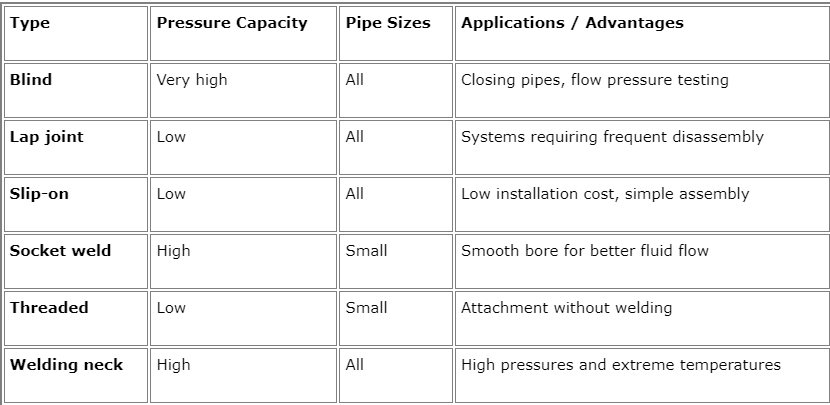Dec. 24, 2022
Table of contents
The flange is a common pipe connection, it is a disc-shaped part, usually used in pairs.
Flanges are mainly used for sealing parts between pipes and valves, between pipes and pipes, and between pipes and equipment.
Flange connection is different from groove connection, welding and thread connection, and has unique advantages in pipeline system, mainly in the advantages of convenient installation and easy maintenance.
Generally, there are round holes on the flange for fixing. For example, when using at the joint of the pipeline, add a sealing ring between the two flanges, and then tighten the connection with bolts. Flanges with different pressures have different pressures. Different thicknesses and different bolts are used. The main materials used for flanges are carbon steel, stainless steel and alloy steel, etc.
Due to the important role played by the flange and its good comprehensive performance, it is widely used in chemical, petrochemical, fire-fighting and drainage industries.
The structure of the flange is relatively simple. It consists of three parts: the upper and lower flanges, the gasket in the middle, and several bolts and nuts.
From the definition of flanges, we can know that there are many kinds of flanges, and their classification needs to be distinguished from different dimensions. For example, flanges can be divided into threaded flanges, grooved flanges according to the connection method. These are also common flanges.
The flange of the threaded flange has threads inside, which requires that the internally connected pipes also have external threads to realize the connection. It is a non-welded flange, so it has the advantage of easy installation and disassembly compared with other welded flanges. It is not suitable to use threaded flanges in environments with extremely high or extremely low temperatures, because the threads are prone to pipeline leakage after thermal expansion and contraction.

The figure below shows a grooved flange, which is a combination of grooved and flanged connections. One end can be screwed through the flange, and the other end through the groove. This kind of component cleverly combines two connection methods, and has good results under some special conditions of use.
As a connecting and sealing component, flanges will leak if there are quality problems in the production process, resulting in economic losses, environmental damage and even safety accidents, so the welding and production of flanges is very important. At present, there are two main production processes of flanges, forging and casting. Let's take a look at these two main production processes and see what are the differences between them.
The forged flange is hammered countless times by a forging machine to make the internal structure of the steel tight, so the mechanical properties will be better and the strength will be high. The forged flange is mainly suitable for those pipelines with high pressure.
The first is to cut the cylindrical billet according to a certain size, heat it to a certain temperature to make it thermoplastic, and put it on the cold heading to let the forging machine continuously beat the billet, so that the inside of the billet is more compact and the mechanical properties are improved. Much better than the original billet.
The round hole on the flange should also be stamped out on the billet by a punching machine, and the formed blank flange should be put into an electric furnace for heat treatment to increase the strength of the flange, and finally the flange blank should be cut and polished to become a usable flange.
Casting flanges have the characteristics of low manufacturing cost and high efficiency, and flanges with relatively complex shapes can be manufactured. Cast flanges are mainly suitable for pipelines with low pressure.
Casting flange is also a commonly used manufacturing process. Metal is melted into liquid steel, and the molten steel is poured into a metal mold that is preheated and kept at a constant temperature to form the shape of the flange. After the casting is naturally cooled for a period of time, then use water to quickly cool it down and demold it, which can also increase the strength of the flange, and finally it can be used after polishing and anti-rust treatment.
Hebei Jianzhi Group is a professional manufacturer of casting pipe fittings in China, with 40 years of casting experience, and its products are sold to more than 100 countries around the world. Jianzhi Group also produces cast flange fittings, especially grooved flanges, which are the superior products of Jianzhi Group. You can click the link below to enter the official YouTube channel of Jianzhi Group to learn more about the production of malleable steel pipe fittings. Of course, if you are interested in purchasing, please contact us.
SAFER
PRODUCT INFO
ABOUT JIANZHI
TECH DATA
Contact Us
E-mail: sales1@jianzhi-fitting.com
Tel: +86 18698027872
Office In Tianjin:
Heping District, Tianjin, China.
Production Base 1:
Chifeng, Inner Mongolia, China.
Production Base 2:
Tangshan City, Hebei Province, China.
Production Base 3:
Schelei Street,Baicoi City,Prahova County,Romania
Service email: info.ro@jianzhi-fitting.com
Sales email: market.ro@jianzhi-fitting.com
Tel: +40(755)011 849
